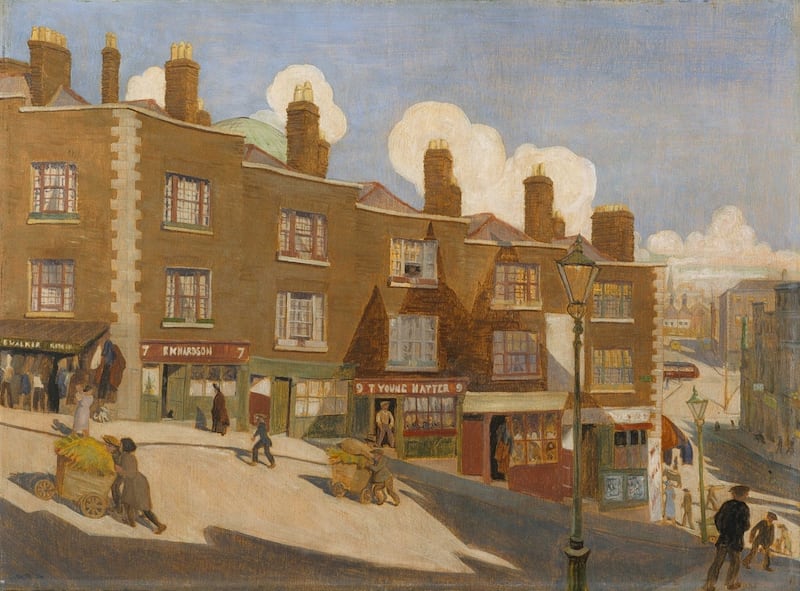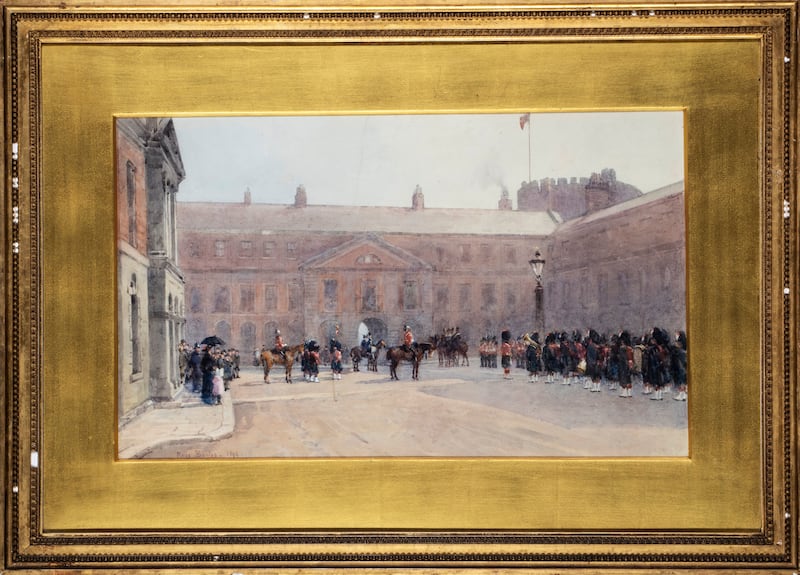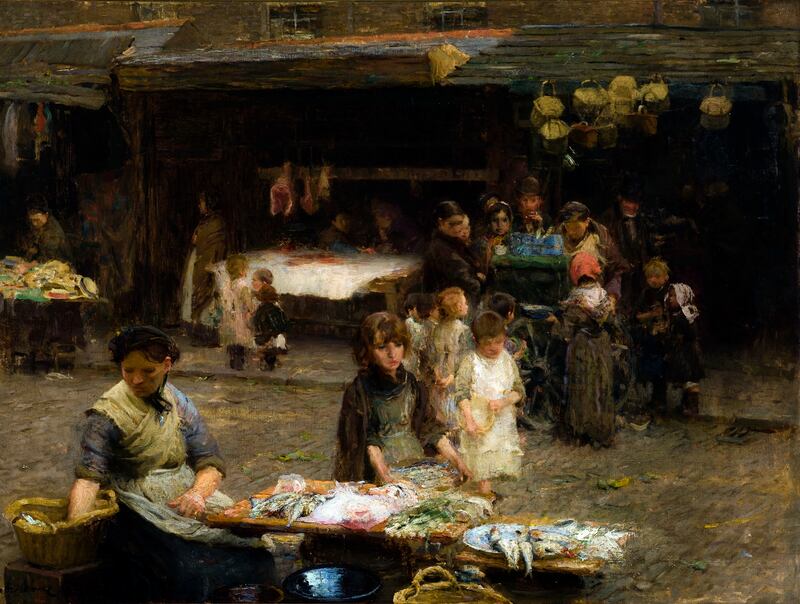Art can show us familiar things in such striking ways that we may always carry a little extra with us afterwards. Parisian neighbourhood bistros make me feel all louchely Impressionist, while lonely late-night cafes on New York street corners bring out an Edward-Hopper spirit.
It’s possible that romance plays a part. Lowry doesn’t quite compel my fascination with the north of England and Hogarth doesn’t drive me to, or from, gin in London, but I had always thought that Dublin saved her inspiration for writers. Now, a new book casts a fresh eye on the artists who made the city their subject.
It is true, agrees Kathryn Milligan, whose book, Painting Dublin, covers the years 1886 to 1949. "If you do an English degree, it's Ulysses, Patrick Kavanagh, maybe Maeve Binchy. " Instead, Milligan who studied art history at University College Dublin and later took a PhD at Trinity College, became fascinated by Harry Kernoff. "There was very little written about him," she says.

“He was painting these industrial areas of Dublin and when he was good, he was very good.” Admitting that, like many artists, he varies in quality, she notes that while popular in his lifetime, Kernoff then fell out of fashion. “I loved those Dublin paintings and I wanted to see how that fitted into a wider representation, I wanted to see who else was painting the city.”
Born in the Rotunda Hospital, Dublin, Milligan grew up in Kildare but the capital had always held an enduring fascination. “I was always desperate to come to Dublin,” she says. “We’d come up at Christmas and ‘do’ the windows.” Her birthday request when she was 13 was to go to the city with her friends.
“My parents reluctantly agreed. I think we got off the bus around Bachelor’s Walk, went to Forbidden Planet, went to the Bad Ass Cafe. We didn’t go very far. It seemed like a huge adventure but I had very little sense of how different parts of the city fitted together.”
Changing city
Taking six artists as a guide, alongside Kernoff, Painting Dublin explores the work of Walter Osborne, Rose Mary Barton, Jack Butler Yeats, Estella Frances Solomons and Flora Mitchell. Clearly they are not all household names, and yet together they shape a fascinating tapestry of a changing city. But why did the literature of Dublin get so much more attention than the painting?
It is said that James Joyce drew Dublin so thoroughly and evocatively in words that you could reconstruct the city, should it disappear, from the pages of Ulysses. It is a claim that has endured but is diminished when you realise that it was Joyce who made it. . . One reason that we think less of cities in Irish art is that we are sidetracked by the emphasis that was placed on the rural landscape and the western seaboard as part of the emergent Free State's project to shape a national identity. In that, it had an eloquent champion in Paul Henry, who so caught the west's vistas and cloudscapes that you can feel, uncannily, as if you have stepped into one of his paintings when you are among them.

Perhaps it is also an unfortunate truth that it was easier for artists to make rural poverty more picturesque, or easier for the patrons and buyers of the art to romanticise shawl-draped peasants when presented against rural backdrops. "Walter Osborne does that," Milligan agrees. His The Fishmarket, Patrick Street (1893) is shown in one of the book's colour plates. In the same vein, the intriguing Picturesque Dublin: Old and New, published in 1898, by Frances Gerard and illustrated by Rose Barton, describes Patrick Street as "a squalid but picturesque ghetto".
Not all the artists’ work could be reproduced in the book. When Flora Mitchell died, the copyright passed to a sister – who also died without children – so while one can see her works online in the National Gallery’s collection, her evocative and gritty drawings and prints have to be described, rather than shown, in the book.

Kernoff
Moving to Dublin for college, Milligan found a flat on Stamer Street.
“A complete coincidence, I found it on Daft, but it was the same street where Harry Kernoff had lived. I went to see it out of that sense of coincidence – but it turned out to be a really nice flat. Living within the canals,” she continues, “changes your understanding of the city. I’m now in Kilmainham, at the top of the building, where I can see the spire on St George’s Church on Hardwicke Place. It’s the image the book opens with. As you live, you build up all these layers of connection with the city.”
Kernoff, who today is best known for his paintings and woodcuts of Davy Byrne's pub, was born in London to Russian Jewish and Spanish parents. Moving to Dublin at the age of 14, he studied under Seán Keating, and combined Keating's romantic realism with modernist influences as well as some socialist realism. It was a compelling cocktail and you can see his influence in the popular works of artists such as Graham Knuttel.
Such was Kernoff's fame in his lifetime, he represented Ireland in painting at the 1928 Olympics. Four years previously, Jack Yeats had won the State's first ever Olympic medal in the same competition, with his glorious The Liffey Swim. Artworks in the competition had to be inspired by sport. The news that breakdancing is to become an Olympic event in 2024 makes me wonder if such lateral thinking could lead to painting, once again, being included.

Permission to paint
At heart an academic text, rich in references and footnotes, Painting Dublin is also a good read due to Milligan’s passion for her subject and her engaging style. While she is an academic, she doesn’t let that dampen her insightful wit. “I did a big survey,” she tells me.
"And St Patrick's Cathedral came up top as most painted building, with Stephen's Green and the quays as runners up." She describes going through exhibition catalogues at Trinity Library, the National Library, the National Gallery and the National Irish Visual Arts Library. A problem was that the earlier catalogues weren't illustrated so she had to match up works to their descriptions.
Problems also faced artists wanting to draw and paint Dublin in the past. During the periods of war and revolution, you needed permits to sketch. “I had great conversations with the archivists and staff at the Garda Museum at Dublin Castle. There isn’t a surviving list of who had permission but you can find individual permits and also records of people breaking the law.”
Estella Solomons was a member of Cumann na mBan and she had permission to sketch in parks but not on the city streets. She hid people on the run in her studio on Pearse Street and also got into trouble for not – as it were – sticking to flowers and trees. Solomons was caught sketching on Wellington Quay. “It reminds us that Dublin was going through this major world event,” says Milligan. “And it reminds us of the power of the image and what could have happened if it fell into the wrong hands.”

Urban life
The book, says Milligan, is asking people to discover new works but also to look at more familiar ones in a different way. “They are of urban life and that urban life is as much a part of Irish identity as Achill or Connemara – there’s a visual history that’s been hiding in plain sight.”
Some of that visual history is of lost buildings and interiors. Milligan points to Kernoff’s interiors of the Theatre Royal, and Flora Mitchell’s of the Irish House, also destroyed. Patrick Street, as painted by Walter Osborne, was gone in his lifetime. “The city changes all the time. Some of those changes are good: the provision of housing, moving people out of the tenements; but there are parts of our architectural history that we won’t get back.”
One discovery was of a series of watercolours by Rose Barton of Huguenot housing around Chambré Street (now Chamber Street). “These are gone now but you’ll see the Huguenots still in street names. When I saw the paintings, I had never thought that there would have been these Dutch-style houses in Dublin.”
Visualising Dublin's history taps into a rich vein. Milligan points to the Irish Film Institute's digitised newsreel footage, available at ifiplayer.ie, as well as the work in exploring old photography by Justin Carville at the Dún Laoghaire Institute of Art, Design and Technology. Looking to the present, a contemporary artist whose dates fall outside the scope of the book is Francis Matthews, whose works, often on exhibition at the Molesworth Gallery in Dublin, are now adding to the story.
Painting Dublin “connects us to the history of the city, to these artists and Dubliners who were here before us,” says Milligan. “People who weren’t always born here but who came to the city and made a life here. It hasn’t always been so much in the public’s consciousness but it is coming back.”
Painting Dublin, 1886-1949: Visualising a Changing City is published by Manchester University Press





















